201871010117--石欣钰--《面向对象程序设计(java)》第十六周学习总结
|
项目 |
内容 |
|
这个作业属于哪个课程 |
https://www.cnblogs.com/nwnu-daizh |
|
这个作业的要求在哪里 |
https://www.cnblogs.com/nwnu-daizh/p/12031970.html |
|
作业学习目标 |
(1) 掌握Java应用程序的打包操作; (2) 掌握线程概念; (3) 掌握线程创建的两种技术。 (4)学习应用程序的GUI |
14.1什么是线程
1.进程--概念
要解释线程,就必须明白什么是进程。
什么是进程呢?
进程是指运行中的应用程序,每个进程都有自己独立的地址空间(内存空间),比如用户点击桌面的IE浏览器,就启动了一个进程,操作系统就会为该进程分配独立的地址空间。当用户再次点击左面的IE浏览器,又启动了一个进程,操作系统将为新的进程分配新的独立的地址空间。目前操作系统都支持多进程。
要点:用户每启动一个进程,操作系统就会为该进程分配一个独立的内存空间。
2.线程--概念
在明白进程后,就比较容易理解线程的概念。
什么是线程呢?
是进程中的一个实体,是被系统独立调度和分派的基本单位,线程自己不拥有系统资源,只拥有一点在运行中必不可少的资源,但它可与同属一个进程的其它线程共享进程所拥有的全部资源。一个线程可以创建和撤消另一个线程,同一进程中的多个线程之间可以并发执行。线程有就绪、阻塞和运行三种基本状态。
3.线程
1、线程是轻量级的进程
2、线程没有独立的地址空间(内存空间)
3、线程是由进程创建的(寄生在进程)
4、一个进程可以拥有多个线程-->这就是我们常说的多线程编程
5、线程有几种状态:
a、新建状态(new)
b、就绪状态(Runnable)
c、运行状态(Running)
d、阻塞状态(Blocked)
e、死亡状态(Dead)
4.线程有什么用处
java程序中流传一句话,不会使用线程就别跟别人说自己学过java。目前绝大部分应用程序都会涉及到多并发的问题。只要应用程序涉及到并发,就离不开多线程编程。
5.线程--如何使用
在java中一个类要当作线程来使用有两种方法。
1、继承Thread类,并重写run函数
2、实现Runnable接口,并重写run函数
因为java是单继承的,在某些情况下一个类可能已经继承了某个父类,这时在用继承Thread类方法来创建线程显然不可能java设计者们提供了另外一个方式创建线程,就是通过实现Runnable接口来创建线程。
14.2中断线程
Terminated (被终止) 线程被终止的原因有二:
(1)一是run()方法中最后一个语句执行完毕而自 然死亡。
(2)二是因为一个没有捕获的异常终止了run方法 而意外死亡。
可以调用线程的stop 方 法 杀 死 一 个 线 程 (thread.stop();),但是,stop方法已过时, 不要在自己的代码中调用它。
其他判断和影响线程状态的方法:
(1)join():等待指定线程的终止。
(2)join(long millis):经过指定时间等待终止指定 的线程。
(3)isAlive():测试当前线程是否在活动。
(4)yield():让当前线程由“运行状态”进入到“就 绪状态”,从而让其它具有相同优先级的等待线程 获取执行权。
14.3线程状态
Java中线程的状态分为6种。
1. 初始(NEW):新创建了一个线程对象,但还没有调用start()方法。
2. 运行(RUNNABLE):Java线程中将就绪(ready)和运行中(running)两种状态笼统的称为“运行”。
线程对象创建后,其他线程(比如main线程)调用了该对象的start()方法。该状态的线程位于可运行线程池中,等待被线程调度选中,获取CPU的使用权,此时处于就绪状态(ready)。就绪状态的线程在获得CPU时间片后变为运行中状态(running)。
3. 阻塞(BLOCKED):表示线程阻塞于锁。
4. 等待(WAITING):进入该状态的线程需要等待其他线程做出一些特定动作(通知或中断)。
5. 超时等待(TIMED_WAITING):该状态不同于WAITING,它可以在指定的时间后自行返回。
6. 终止(TERMINATED):表示该线程已经执行完毕。
这6种状态定义在Thread类的State枚举中,可查看源码进行一一对应。
线程的状态图 
第二部分:实验部分
1、实验目的与要求
(1) 掌握Java应用程序的打包操作;
(2) 掌握线程概念;
(3) 掌握线程创建的两种技术。
2、实验内容和步骤
实验1: 导入第13章示例程序,测试程序并进行代码注释。
测试程序1
l 在elipse IDE中调试运行教材585页程序13-1,结合程序运行结果理解程序;
l 将所生成的JAR文件移到另外一个不同的目录中,再运行该归档文件,以便确认程序是从JAR文件中,而不是从当前目录中读取的资源。
l 掌握创建JAR文件的方法;
程序代码如下:
package resource; import java.awt.*;
import java.io.*;
import java.net.*;
import java.util.*;
import javax.swing.*; /**
* @version 1.41 2015-06-12
* @author Cay Horstmann
*/
public class ResourceTest
{
public static void main(String[] args)
{
EventQueue.invokeLater(() -> {
JFrame frame = new ResourceTestFrame();
frame.setTitle("ResourceTest");
frame.setDefaultCloseOperation(JFrame.EXIT_ON_CLOSE);
frame.setVisible(true);
});
}
} /**
* A frame that loads image and text resources.
*/
class ResourceTestFrame extends JFrame
{
private static final int DEFAULT_WIDTH = 300;
private static final int DEFAULT_HEIGHT = 300; public ResourceTestFrame()
{
setSize(DEFAULT_WIDTH, DEFAULT_HEIGHT);
URL aboutURL = getClass().getResource("about.gif");//找到指定位置的图像文件,返回一个可以加载资源的URL
Image img = new ImageIcon(aboutURL).getImage();//将加载的about.gif图像设置为图标
setIconImage(img); JTextArea textArea = new JTextArea();
InputStream stream = getClass().getResourceAsStream("about.txt");//读取about.txt文本文件内容
try (Scanner in = new Scanner(stream, "UTF-8"))//将读取到的about.txt文本文件里内容显示到文本区
{
while (in.hasNext())//读取文本文件
textArea.append(in.nextLine() + "\n");
}
add(textArea);
}
}
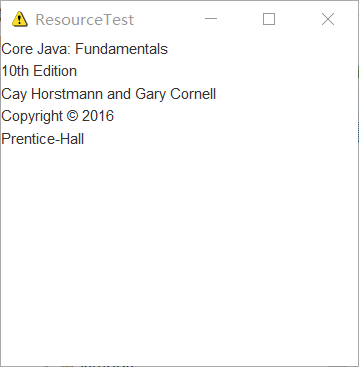
归档:
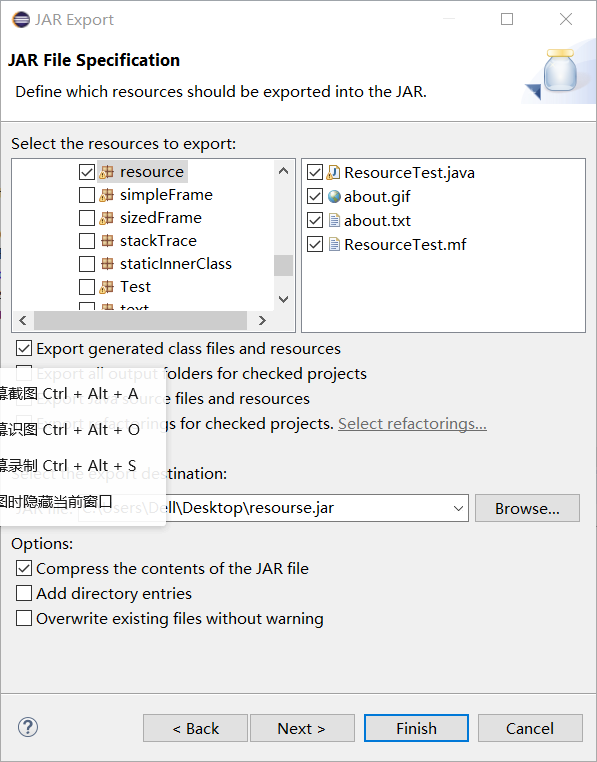
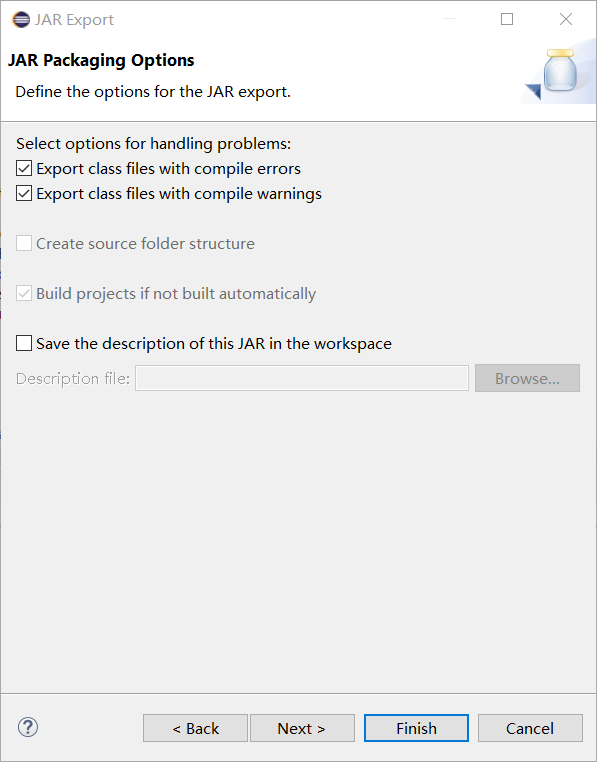

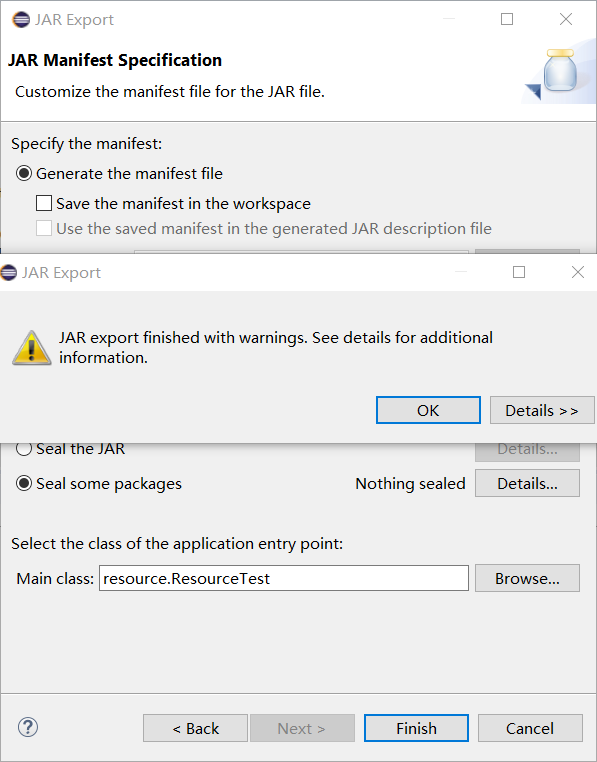

实验1:测试程序2(10分)
在elipse IDE中调试运行ThreadTest,结合程序运行结果理解程序;
掌握线程概念;
掌握用Thread的扩展类实现线程的方法;
利用Runnable接口改造程序,掌握用Runnable接口创建线程的方法。
代码如下:
class Lefthand extends Thread {
public void run()
{
for(int i=0;i<=5;i++)
{ System.out.println("You are Students!");
try{ sleep(500); }
catch(InterruptedException e)
{ System.out.println("Lefthand error.");}
}
}
}
class Righthand extends Thread {
public void run()
{
for(int i=0;i<=5;i++)
{ System.out.println("I am a Teacher!");
try{ sleep(300); }
catch(InterruptedException e)
{ System.out.println("Righthand error.");}
}
}
}
public class ThreadTest
{
static Lefthand left;
static Righthand right;
public static void main(String[] args)
{ left=new Lefthand();
right=new Righthand();
left.start();
right.start();
}
}
实验输出结果截图为:

利用Runnable接口改造后的程序代码为:
package Thread;
class Lefthands implements Runnable{
public void run() {
for(int i=0;i<=5;i++)
{ System.out.println("You are Students!");
try{ Thread.sleep(500); } //休眠时间为500ms
catch(InterruptedException e) //中断异常
{ System.out.println("Lefthand error.");}
}
}
}
class Righthands implements Runnable{
public void run() {
for(int i=0;i<=5;i++)
{ System.out.println("I am a Teacher!");
try{ Thread.sleep(300); }
catch(InterruptedException e)
{ System.out.println("Righthand error.");}
}
}
}
public class TheadTest01 {
public static void main(String args[]) {
Lefthands L=new Lefthands();
Righthands R=new Righthands();
new Thread(L).start();//启动线程
new Thread(R).start();
}
}
实验输出结果截图为:

可以通过两种方法实现多线程,分别为:(1)利用Thread类的子类(2)用Runnable()接口实现线程
(1)——定义Thread类的子类并实现用户线程操作,即 run()方法的实现。
——在适当的时候启动线程。
(2)——首先设计一个实现Runnable接口的类;
——然后在类中根据需要重写run方法;
——再创建该类对象,以此对象为参数建立Thread 类的对象;
——调用Thread类对象的start方法启动线程,将 CPU执行权转交到run方法。
测试程序3:
l 在Elipse环境下调试教材625页程序14-1、14-2 、14-3,结合程序运行结果理解程序;
l 在Elipse环境下调试教材631页程序14-4,结合程序运行结果理解程序;
l 对比两个程序,理解线程的概念和用途;
l 掌握线程创建的两种技术。
package bounce; import java.awt.geom.*; /**
* A ball that moves and bounces off the edges of a rectangle
* @version 1.33 2007-05-17
* @author Cay Horstmann
*/
public class Ball
{
private static final int XSIZE = 15;
private static final int YSIZE = 15;
private double x = 0;
private double y = 0;
private double dx = 1;
private double dy = 1; /**
* Moves the ball to the next position, reversing direction if it hits one of the edges
*/
public void move(Rectangle2D bounds)
{
x += dx;
y += dy;
if (x < bounds.getMinX())
{
x = bounds.getMinX();
dx = -dx;//当球碰壁时回调球的位置
}
if (x + XSIZE >= bounds.getMaxX())
{
x = bounds.getMaxX() - XSIZE;
dx = -dx;
}
if (y < bounds.getMinY())
{
y = bounds.getMinY();
dy = -dy;
}
if (y + YSIZE >= bounds.getMaxY())
{
y = bounds.getMaxY() - YSIZE;
dy = -dy;
}
} /**
* Gets the shape of the ball at its current position.
*/
public Ellipse2D getShape()
{
return new Ellipse2D.Double(x, y, XSIZE, YSIZE);
}
}
package bounce; import java.awt.*;
import java.util.*;
import javax.swing.*; /**
* The component that draws the balls.
* @version 1.34 2012-01-26
* @author Cay Horstmann
*/
public class BallComponent extends JPanel
{
private static final int DEFAULT_WIDTH = 450;
private static final int DEFAULT_HEIGHT = 350; private java.util.List<Ball> balls = new ArrayList<>(); /**
* Add a ball to the component.
* @param b the ball to add
*/
public void add(Ball b)
{
balls.add(b);
} public void paintComponent(Graphics g)
{
super.paintComponent(g); // erase background
Graphics2D g2 = (Graphics2D) g;
for (Ball b : balls)
{
g2.fill(b.getShape());
}
} public Dimension getPreferredSize() { return new Dimension(DEFAULT_WIDTH, DEFAULT_HEIGHT); }
}
package bounce; import java.awt.*;
import java.awt.event.*;
import javax.swing.*; /**
* Shows an animated bouncing ball.
* @version 1.34 2015-06-21
* @author Cay Horstmann
*/
public class Bounce
{
public static void main(String[] args)
{
EventQueue.invokeLater(() -> {
JFrame frame = new BounceFrame();
frame.setDefaultCloseOperation(JFrame.EXIT_ON_CLOSE);
frame.setVisible(true);
});
}
} /**
* The frame with ball component and buttons.
*/
class BounceFrame extends JFrame
{
private BallComponent comp;
public static final int STEPS = 1000;
public static final int DELAY = 3; /**
* Constructs the frame with the component for showing the bouncing ball and
* Start and Close buttons
*/
public BounceFrame()
{
setTitle("Bounce");
comp = new BallComponent();
add(comp, BorderLayout.CENTER);
JPanel buttonPanel = new JPanel();
addButton(buttonPanel, "Start", event -> addBall()); //start表示加入一个球
addButton(buttonPanel, "Close", event -> System.exit(0));//系统退出
add(buttonPanel, BorderLayout.SOUTH);
pack();
} /**
* Adds a button to a container.
* @param c the container
* @param title the button title
* @param listener the action listener for the button
*/
public void addButton(Container c, String title, ActionListener listener)
{
JButton button = new JButton(title);
c.add(button);
button.addActionListener(listener);
} /**
* Adds a bouncing ball to the panel and makes it bounce 1,000 times.
*/
public void addBall()
{
try
{
Ball ball = new Ball();
comp.add(ball); for (int i = 1; i <= STEPS; i++)
{
ball.move(comp.getBounds());
comp.paint(comp.getGraphics());
Thread.sleep(DELAY);
}
}
catch (InterruptedException e)//中断异常
{
}
}
}
实验输出结果截图为:
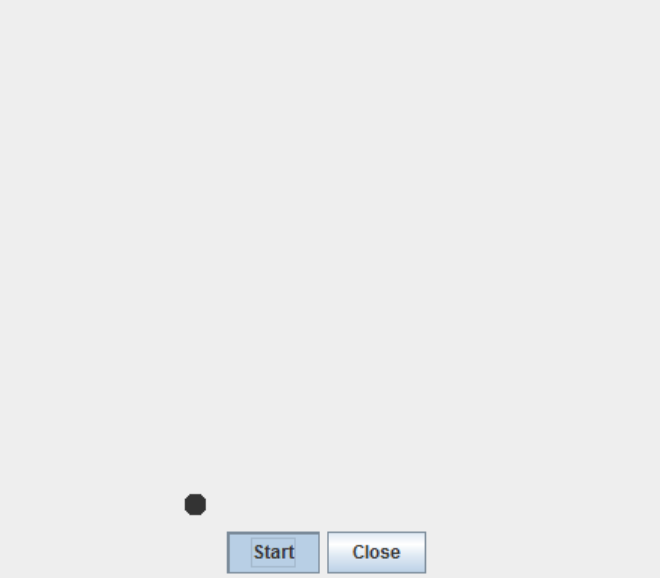
bounceThread
package bounceThread; import java.awt.geom.*; /**
A ball that moves and bounces off the edges of a
rectangle
* @version 1.33 2007-05-17
* @author Cay Horstmann
*/
public class Ball
{
private static final int XSIZE = 15;
private static final int YSIZE = 15;
private double x = 0;
private double y = 0;
private double dx = 1;
private double dy = 1; /**
Moves the ball to the next position, reversing direction
if it hits one of the edges
*/
public void move(Rectangle2D bounds)
{
x += dx;
y += dy;
if (x < bounds.getMinX())
{
x = bounds.getMinX();
dx = -dx;
}
if (x + XSIZE >= bounds.getMaxX())
{
x = bounds.getMaxX() - XSIZE;
dx = -dx;
}
if (y < bounds.getMinY())
{
y = bounds.getMinY();
dy = -dy;
}
if (y + YSIZE >= bounds.getMaxY())
{
y = bounds.getMaxY() - YSIZE;
dy = -dy;
}
} /**
Gets the shape of the ball at its current position.
*/
public Ellipse2D getShape()
{
return new Ellipse2D.Double(x, y, XSIZE, YSIZE);
}
}
package bounceThread; import java.awt.*;
import java.util.*;
import javax.swing.*; /**
* The component that draws the balls.
* @version 1.34 2012-01-26
* @author Cay Horstmann
*/
public class BallComponent extends JComponent
{
private static final int DEFAULT_WIDTH = 450;
private static final int DEFAULT_HEIGHT = 350; private java.util.List<Ball> balls = new ArrayList<>(); /**
* Add a ball to the panel.
* @param b the ball to add
*/
public void add(Ball b)
{
balls.add(b);
} public void paintComponent(Graphics g)
{
Graphics2D g2 = (Graphics2D) g;
for (Ball b : balls)
{
g2.fill(b.getShape());
}
} public Dimension getPreferredSize() { return new Dimension(DEFAULT_WIDTH, DEFAULT_HEIGHT); }
}
package bounceThread; import java.awt.*;
import java.awt.event.*; import javax.swing.*; /**
* Shows animated bouncing balls.
* @version 1.34 2015-06-21
* @author Cay Horstmann
*/
public class BounceThread
{
public static void main(String[] args)
{
EventQueue.invokeLater(() -> {
JFrame frame = new BounceFrame();
frame.setTitle("BounceThread");
frame.setDefaultCloseOperation(JFrame.EXIT_ON_CLOSE);
frame.setVisible(true);
});
}
} /**
* The frame with panel and buttons.
*/
class BounceFrame extends JFrame
{
private BallComponent comp;
public static final int STEPS = 1000;
public static final int DELAY = 5; /**
* Constructs the frame with the component for showing the bouncing ball and
* Start and Close buttons
*/
public BounceFrame()
{
comp = new BallComponent();
add(comp, BorderLayout.CENTER);
JPanel buttonPanel = new JPanel();
addButton(buttonPanel, "Start", event -> addBall());
addButton(buttonPanel, "Close", event -> System.exit(0));
add(buttonPanel, BorderLayout.SOUTH);
pack();
} /**
* Adds a button to a container.
* @param c the container
* @param title the button title
* @param listener the action listener for the button
*/
public void addButton(Container c, String title, ActionListener listener)
{
JButton button = new JButton(title);
c.add(button);
button.addActionListener(listener);
} /**
* Adds a bouncing ball to the canvas and starts a thread to make it bounce
*/
public void addBall()
{
Ball ball = new Ball();
comp.add(ball);
Runnable r = () -> {
try
{
for (int i = 1; i <= STEPS; i++)
{
ball.move(comp.getBounds());
comp.repaint();
Thread.sleep(DELAY);
}
}
catch (InterruptedException e)
{
}
};
Thread t = new Thread(r);
t.start();
}
}
实验输出结果截图为:

201871010117--石欣钰--《面向对象程序设计(java)》第十六周学习总结的更多相关文章
- 201571030332 扎西平措 《面向对象程序设计Java》第八周学习总结
<面向对象程序设计Java>第八周学习总结 项目 内容 这个作业属于哪个课程 https://www.cnblogs.com/nwnu-daizh/ 这个作业的要求在哪里 https: ...
- 201771010118马昕璐《面向对象程序设计java》第八周学习总结
第一部分:理论知识学习部分 1.接口 在Java程序设计语言中,接口不是类,而是对类的一组需求描述,由常量和一组抽象方法组成.Java为了克服单继承的缺点,Java使用了接口,一个类可以实现一个或多个 ...
- 201771010134杨其菊《面向对象程序设计java》第八周学习总结
第八周学习总结 第一部分:理论知识 一.接口.lambda和内部类: Comparator与comparable接口: 1.comparable接口的方法是compareTo,只有一个参数:comp ...
- 201771010134杨其菊《面向对象程序设计java》第七周学习总结
第七周学习总结 第一部分:理论知识 1.继承是面向对象程序设计(Object Oriented Programming-OOP)中软件重用的关键技术.继承机制使用已经定义的类作为基础建立新的类定义,新 ...
- 201771010128 王玉兰《面象对象程序设计 (Java) 》第六周学习总结
---恢复内容开始--- 第一部分:基础知识总结: 1.继承 A:用已有类来构建新类的一种机制,当定义了一个新类继承一个类时,这个新类就继承了这个类的方法和域以适应新的情况: B:特点:具有层次结构. ...
- 201871010126 王亚涛《面向对象程序设计 JAVA》 第十三周学习总结
内容 这个作业属于哪个课程 https://www.cnblogs.com/nwnu-daizh/ 这个作业的要求在哪里 https://www.cnblogs.com/nwnu-daizh/p/ ...
- 马凯军201771010116《面向对象程序设计Java》第八周学习总结
一,理论知识学习部分 6.1.1 接口概念 两种含义:一,Java接口,Java语言中存在的结构,有特定的语法和结构:二,一个类所具有的方法的特征集合,是一种逻辑上的抽象.前者叫做“Java接口”,后 ...
- 周强201771010141《面向对象程序设计Java》第八周学习总结
一.理论知识学习部分 Java为了克服单继承的缺点,Java使用了接口,一个类可以实现一个或多个接口. 接口体中包含常量定义和方法定义,接口中只进行方法的声明,不提供方法的实现. 类似建立类的继承关系 ...
- 201777010217-金云馨《面向对象程序设计Java》第八周学习总结
项目 内容 这个作业属于哪个课程 https://www.cnblogs.com/nwnu-daizh/ 这个作业的要求在哪里 https://www.cnblogs.com/nwnu-daizh/p ...
- 201871010126 王亚涛 《面向对象程序设计 (Java)》第十七周学习总结
内容 这个作业属于哪个课程 https://www.cnblogs.com/nwnu-daizh/ 这个作业的要求在哪里 https://www.cnblogs.com/nwnu-daizh/p/12 ...
随机推荐
- 【转】Redis面试题
1.谈谈Redis的主从复制流程 有几个重点:主节点负责写,从节点负责读,slave node 主要用来进行横向扩容,做读写分离,扩容的 slave node 可以提高读的吞吐量.必须开启 maste ...
- Leetcode4__findMedianSortedArrays
findMedianSortedArrays 基本思路:通过指针按顺序移动来判断大小顺序,思路和有一道用链表求中间值一样: class Solution { public double findMed ...
- Educational Codeforces Round 78 (Rated for Div. 2) 题解
Shuffle Hashing A and B Berry Jam Segment Tree Tests for problem D Cards Shuffle Hashing \[ Time Lim ...
- Spark SQL中出现 CROSS JOIN 问题解决
Spark SQL中出现 CROSS JOIN 问题解决 1.问题显示如下所示: Use the CROSS JOIN syntax to allow cartesian products b ...
- 纯CSS打造BiliBili样式博客主题
前言 一直以来,我都在思考如何减少不必要的JS代码,仅通过CSS来实现博客园主题美化.CSS有很多魔法代码,例如:before,iconfont,order,等等,利用好这些技巧,也能实现很好美化效果 ...
- Win10修改hosts文件并配置DNS
1.打开C:\Windows\System32\drivers\etc目录 2.去掉hosts文件的只读属性 3.添加dns解析配置 127.0.0.1 www.example.c ...
- antd模块组件文档思维导图整理
- RestTemplate的三种请求方式
转载 https://blog.csdn.net/qq_36364521/article/details/84203133
- Knative 应用在阿里云容器服务上的最佳实践
作者|元毅 阿里云智能事业群高级开发工程师 相信通过前面几个章节的内容,大家对 Knative 有了初步的体感,那么在云原生时代如何在云上玩转 Knative?本篇内容就给你带来了 Knative 应 ...
- UWP使用TreeView
这个帖子本来是不想写的,但是感觉网上类似的也没有,对于小白可能有点用,于是想着还是写一下吧. 写之前想说下,UWP其实并没有死掉,对于win10来说,以后的新设备肯定是支持UWP的,而且微软一直在完善 ...
